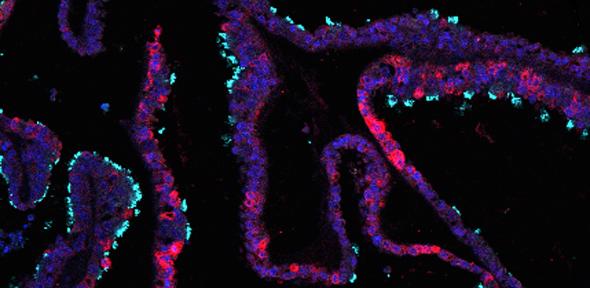
The mucosal lining inside the uterus is called the endometrium. Over the course of the menstrual cycle, its composition changes, becoming thicker and rich with blood vessels in preparation for pregnancy, but if the woman does not conceive, the uterus sheds this tissue, causing the woman’s period.
A team from the Centre for Trophoblast Research, which this year celebrates its tenth anniversary, was able to grow the organoids in culture from cells derived from endometrial tissue and maintain the organoids in culture for several months, faithfully reproducing the genetic signature of the endometrium – in other words, the pattern of activity of genes in the lining of the uterus. They also demonstrated that the organoids respond to female sex hormones and early pregnancy signals, secreting what are collectively known as ‘uterine milk’ proteins that nourish the embryo during the first months of pregnancy.
The findings of the study, funded by the Medical Research Council, the Wellcome Trust and the Centre for Trophoblast Research, are published today in the journal Nature Cell Biology.

The organoids are capable of generating both secretory (red) and epithelial (cyan) cells of the uterus. Image: Centre for Trophoblast Research
“These organoids provide a major step forward in investigating the changes that occur during the menstrual cycle and events during early pregnancy when the placenta is established,” says Dr Margherita Turco, the study’s first author. “These events are impossible to capture in a woman, so until now we have had to rely on animal studies.”
“Events in early pregnancy lay the foundations for a successful birth, and our new technique should provide a window into this events,” adds Professor Graham Burton, Director of the Centre for Trophoblast Research, and joint senior author with Ashley Moffett of the study. “There’s increasing evidence that complications of pregnancy, such as restricted growth of the fetus, stillbirth and pre-eclampsia – which appear later in pregnancy – have their origins around the time of implantation, when the placenta begins to develop.”
Research in animal species such as mice and sheep has shown that factors secreted by the endometrial glands are critical for enabling a developing fertilised egg (known as the ‘conceptus’) to implant into the wall of the uterus. There is also strong evidence that the conceptus sends signals to the endometrial glands that then stimulate the development of the placenta. In this way, the conceptus is able to stimulate its own development through a ‘dialogue’ with the mother; if it fails, the result is loss of the pregnancy or severe growth restriction of the fetus.
Professor Burton and colleagues believe that using the organoids will allow them to investigate in greater detail how the conceptus communicates with the glands, identifying the full repertoire of factors released in response and testing their effects on placental tissues. His team will be collaborating with the Bourn Hall Clinic – a fertility clinic near Cambridge – to investigate whether parts of this circuitry are impaired or deficient in women experiencing difficulty in conceiving, and if so to devise potential new treatments.
The technique also enables the researchers to grow organoids from endometrial cancer cells. As proof-of-principle, this will allow them to model and understand diseases of the endometrium, including cancer of the uterus and endometriosis.
Organoid cultures have proven to be powerful tools for investigating the behaviour of other organ systems. Members of the Centre for Trophoblast Research are confident that their new advance will provide a much-needed window on events during the earliest stages of pregnancy, when the conceptus and mother first physically interact.
Reference
Turco, MY et al. Long-term, hormone-responsive organoid cultures of human endometrium in a chemically defined medium. Nature Cell Biology; 10 April 2017; DOI: 10.1038/ncb3516
Scientists at the University of Cambridge have succeeded in growing miniature functional models of the lining of the womb (uterus) in culture. These organoids, as they are known, could provide new insights into the early stages of pregnancy and conditions such as endometriosis, a painful condition that affects as many as two million women in the UK.

The text in this work is licensed under a Creative Commons Attribution 4.0 International License. For image use please see separate credits above.